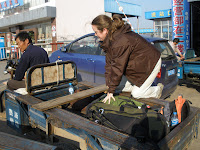

Across the rock I watched Za take a photo of herself, wearing my sunglasses, with her camera phone. As I watched her, I couldn't help to think how our sixteen year old trekking guide symbolizes the changes across generations among the Black H'mong (and other minorities) in the villages of Sapa.
We took a two day trek to some of the different villages around Sapa. The morning April and I met Za she was dressed in traditional Black H'mong clothing but, I noticed some of the subtle fashion statements she made. Instead of her hair twisted into a top knot and the traditional head wrap, she had her long hair pulled back and secured with a fuzzy, neon green band. Long, dangle star earrings replaced the traditional thick, heavy silver hoops that elongated the lobes of Za's elders. Soon into our trek

we began interrogating Za and it soon led to boyfriends. Her older sister by two years had just married. She shrieked, "I don't want to be married! I want to be a career woman." Again, another sign of the changes from the traditions in the villages.
The three of us set out for our two day trek and were quickly joined by two other women who we thought were just keeping Za company until we arrived at our lunch spot and they pulled out purses and earrings asking us to buy from them. April and I enjoyed their company and their occasional hand to help us down steep areas so were happy to support them.
Terraced fields stretched out along the valley. We wat

ched people work in the plots, preparing them for planting. Every family owns at least one water buffalo, a crucial commodity.
After lunch the three of us hiked just a short while before arriving at our home stay for the night. We were the only guests and were warmly received by the owner and his family. They fed us extremely well at each meal.
That evening Za took us for a walk around the village which was where her family also lived. My most memorable moment was visiting a family that she knows. We walked through the gate and into the family farm. From the simple wooden frame house we could hear singing from inside. We walked through the open doors which was similar to walking into a barn. The floor was compact dirt and there was a tarp lying in the middle. It was a rectangle with a small loft above. In one corner there was a bed made of boards set on top of cinder blocks. Eleven children ranging from 3 to 15 years of age were on the tarp singing and dancing to Christian songs. A young man led the group standing at the front of the tarp. A young couple stood towards the back of the tarp, also participating. Sitting on a small stool was an old woman who was watching the group. She gave us all stools and April and I silently sat down to watch the interactions. One young girl's voice rose above the rest and she took pride in directing the others in the next song or hand movem

ents. Later Za told us that she was her younger sister. We could see the similarities in her feisty personality. I was overwhelmed by the simplicity of their home and by the joy everyone had from spending time together. It was a beautiful and special moment that I was fortunate to witness.

The next morning we continued on our trip and were joined by, yet again, by two other women. This time a young girl of 15 and an older woman. The young girl was shy but extremely agile on the narrow, steep paths. I tried to follow her stride as she'd gallop down steep paths. At one point Za led us up into a bamboo forest. She said it was the "easier" way and we were especially in favor of a bamboo forest. What we weren't expecting was having to side-step across a water filled terrace. I clutched both hands of our additional guides as my heart pounded on the slippery terrace wall. Carrying a heavy basket on her back and watching out for both April and I, the older woman certainly had her work cut out for her. Once taking a break

at a waterfall before descending to our lunch spot, she showed off her wares and April and I were happy to purchase some goods. The woman use natural indigo that grows in the valley to dye the fabric that makes up their shirts, belts, bags and baby carriers. You can see many woman with dyed hands and finger nails. The shy, young girl wasn't as aggressive as some of her peers and often took some time on her own.

I caught this picture of her as she stared out to the waterfall.
I had already fallen in love with Sapa before our trek and spending two days in the villages put it at the top of my destinations list.

These kids were along our path on the second day. They followed us down and I took a number of photos of them. Many of the kids ran around with little clothing and bare feet. Several had runny noses, as you may be able to see on the boy in this photo. Just after taking the photo, I took a tissue and wiped it.




















